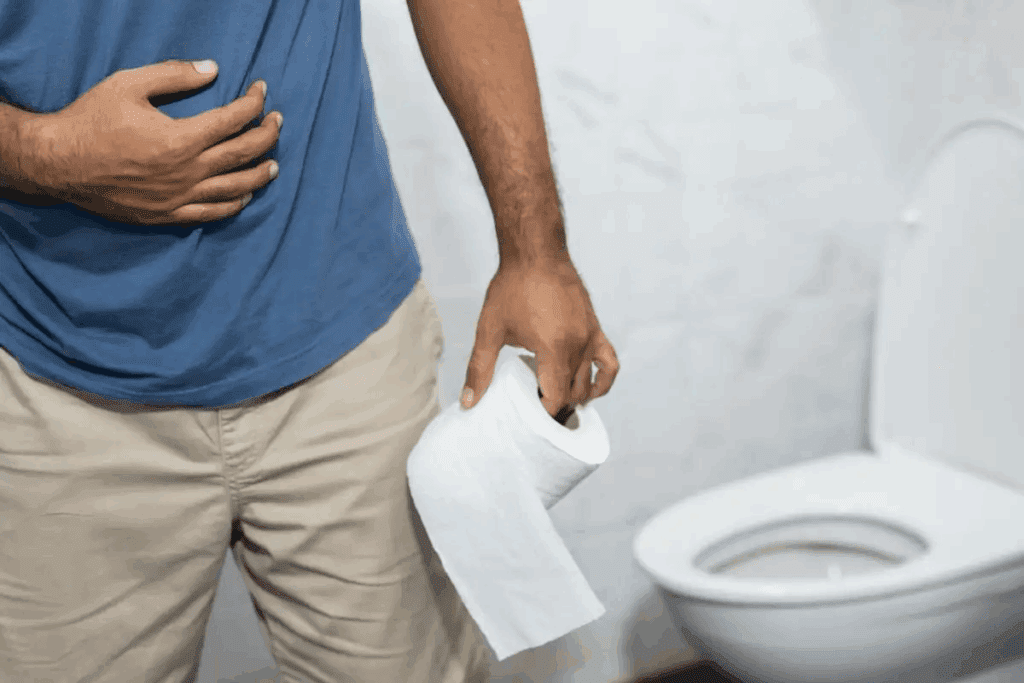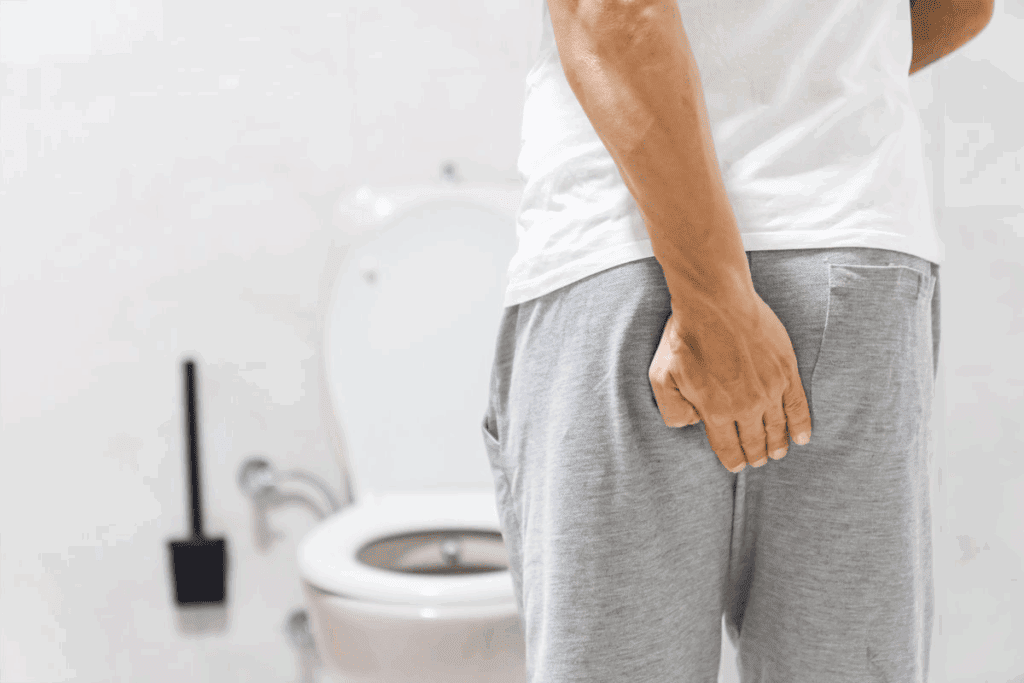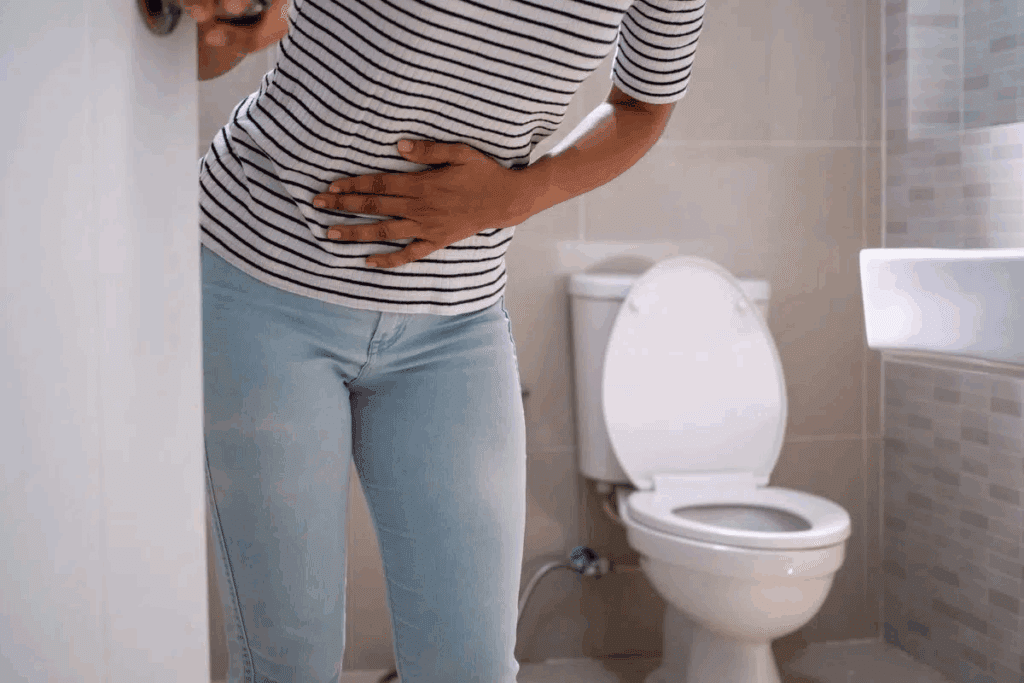Last Updated on November 26, 2025 by Bilal Hasdemir

Feeling unexplained belly pain or diarrhea can be scary. Knowing the main signs of gallbladder problems is key to getting the right help.
Liv Hospital focuses on caring for you first. They aim to treat gallbladder issues well. The most obvious sign is pain in the mid to upper-right belly. This pain is often linked to gallstones.
Do gallbladder issues cause diarrhea? Yes. Learn 10 bad symptoms of gallbladder problems, including pain, gas, and chronic diarrhea.
Spotting these symptoms of gall bladder disease is important. Chronic gallbladder disease can cause ongoing diarrhea and other issues.

The gallbladder is a small but important organ. It stores bile that helps digest fats. It’s located under the liver in the upper right part of the abdomen.
The gallbladder’s main job is to store and concentrate bile. Bile is a digestive fluid made by the liver. When we eat fatty foods, the gallbladder releases bile into the small intestine.
This helps break down fats into smaller parts. These parts can then be absorbed by the body. This process is key for digesting and absorbing fat-soluble vitamins.
“The gallbladder’s role in digestion is often underestimated until problems arise.” Yet, it’s essential for a healthy digestive system.
Gallbladder problems can include gallstones, cholecystitis, and even cancer. Gallstones are hardened bile deposits. Cholecystitis is inflammation of the gallbladder, often caused by gallstones.
Other issues are biliary dyskinesia, where the gallbladder doesn’t work right, and gallbladder polyps, which are growths on the wall.
Several factors can raise your risk of gallbladder disease. Being overweight or obese, eating a high-fat diet, and being over 40 are some. Women, pregnant women, and those on estrogen therapy are more at risk.
Having a family history of gallstones, diabetes, and rapid weight loss also increase risk. Knowing these factors can help prevent or catch problems early. As “early detection is key to effective treatment.”

The link between gallbladder problems and diarrhea is complex. It involves issues with bile flow and fat digestion. The gallbladder stores and releases bile into the small intestine. Bile helps break down fats, making digestion easier.
If the gallbladder doesn’t work right, it can’t release enough bile. This affects fat digestion and might cause diarrhea.
Bile flow is key for regular bowel movements. If bile production or release is off, it can cause malabsorption of fats and vitamins. This malabsorption can lead to diarrhea, as the body has trouble with fatty foods.
Chronic gallbladder disease can cause persistent diarrhea, with some patients having up to 4-10 bowel movements a day.
“Diarrhea is a significant symptom that can greatly impact a patient’s quality of life,” say gastroenterologists. The connection between gallbladder dysfunction and diarrhea is backed by clinical observations and patient reports.
Gallbladder-related diarrhea often has specific traits. It’s usually chronic and can come with other symptoms like abdominal pain, bloating, and gas. Diarrhea is often worse after eating fatty foods, as the body can’t digest fats well.
Gallstone disease is common and affects the gallbladder, causing stones to form. These stones can block bile flow, leading to chronic diarrhea and other symptoms. Gallstones can cause bile duct obstruction, leading to malabsorption and diarrhea.
Understanding the link between gallbladder issues and diarrhea is key for diagnosing and treating gastrointestinal symptoms. By addressing gallbladder dysfunction, healthcare providers can help alleviate symptoms like diarrhea and improve digestive health.
Pain in the upper right abdomen often points to gallbladder problems. This pain can be mild or severe. It gives important clues about the gallbladder’s condition.
Pain from gallbladder issues usually happens in the mid to upper-right part of the abdomen. This area is called the right upper quadrant. The pain might also spread to the back or right shoulder, which is known as referred pain.
Key areas where gallbladder pain is felt:
The type of pain can tell a lot about the gallbladder. Dull pain is often linked to long-term inflammation or gallstones without a blockage. Sharp pain, on the other hand, suggests a more serious issue, like a gallstone blocking the cystic duct.
Characteristics of dull vs. sharp pain:
A constant ache in the gallbladder can signal a serious problem. If the pain doesn’t go away or gets worse, you should see a doctor. Long-term pain can mean ongoing inflammation or infection, which can lead to serious issues if not treated.
“Persistent abdominal pain, specially in the upper right quadrant, should not be ignored. It’s a signal that warrants further investigation into the cause.”
It’s important to watch how long and how bad the pain is. Also, look out for other symptoms like nausea or fever. These can help figure out how serious the gallbladder problem is.
Pain from gallbladder issues can spread to different parts of the body. This is called referred pain. It happens because the nerves that serve the gallbladder also cover other areas. This makes pain seem to come from these other places.
Gallbladder disease can send pain to the back, usually between the shoulder blades. This pain is linked to inflammation or blockage of the gallbladder. It can feel like a dull ache or a sharp, stabbing pain, depending on the cause.
Pain from the gallbladder can also go to the right shoulder or chest. This is because the nerves for the gallbladder and these areas share nerve roots. It’s important to tell this pain apart from heart problems, as the symptoms can be similar.
Telling gallbladder pain from heart pain can be hard because they share symptoms. But, gallbladder pain often gets worse with fatty foods. Heart pain, on the other hand, is usually linked to hard work or stress.
| Characteristics | Gallbladder Pain | Cardiac Pain |
| Location | Upper right abdomen, radiating to back or right shoulder | Center of the chest, radiating to arm, neck, or jaw |
| Triggers | Fatty meals | Exertion, stress |
| Nature | Sharp, stabbing, or dull ache | Pressure, squeezing, or heaviness |
Nausea and vomiting often show up when there’s a problem with the gallbladder. These symptoms can really affect how well you feel. It’s important to know how they relate to gallbladder issues.
Gallbladder disease can cause nausea because it messes with how we digest food. When the gallbladder gets inflamed or blocked, it can cause digestive issues like nausea. This is often worse with fatty or greasy foods.
The reason for nausea in gallbladder disease is complex. It involves bile salts, digestive enzymes, and the gut. When this balance is off, we feel nauseous and uncomfortable.
Nausea after eating can be a sign of gallbladder disease. This is more common after eating fatty or heavy meals. If the gallbladder isn’t working right, we might feel nauseous and uncomfortable.
It’s important to notice when and why we feel nauseous. If it happens after eating, and often after fatty meals, it could mean gallbladder problems. We should see a doctor.
Vomiting is a more serious symptom of gallbladder disease. If we keep vomiting, or if it’s with fever, belly pain, or yellow skin, it’s a sign of a serious problem. We need to get medical help right away.
In serious cases, like when the gallbladder gets gangrenous or perforates, we need quick medical care. Spotting these signs and getting help fast can save our lives.
Digestive distress, like bloating and indigestion, can signal gallbladder disease. A malfunctioning gallbladder causes many uncomfortable digestive problems.
Chronic indigestion often points to gallbladder issues. Indigestion, or dyspepsia, is upper abdominal pain or discomfort. It warns of gallbladder problems.
The gallbladder stores and releases bile for fat digestion. Disruptions in this process cause indigestion. Persistent indigestion may hint at gallbladder issues.
Gallbladder disease can cause food intolerances. A malfunctioning gallbladder hampers digestion of fatty foods. This leads to symptoms after eating.
Common intolerances include fatty or greasy foods. They cause bloating, gas, and discomfort. Managing these intolerances helps ease symptoms.
Bloating is a symptom of gallbladder disease but can also stem from other issues. It’s key to tell gallbladder bloating from other causes for correct diagnosis and treatment.
Gallbladder-related bloating often comes with indigestion and gas. If you have persistent or severe bloating with these symptoms, see a healthcare professional. They can find the root cause.
The color of your stool and urine can tell a lot about your gallbladder health. Changes in these colors can show problems with your gallbladder, like blockages or not working right.
Clay-colored or pale stools might mean you have a bile duct blockage. This happens when bile can’t get to your intestines. It makes your stools lighter. This could be because of gallstones or other gallbladder issues.
Key characteristics of clay-colored stools include:
Dark urine can also point to a bile duct blockage. When bile can’t get to your intestines, it builds up in your blood. This leads to darker urine. You might also see jaundice.
“The presence of dark urine and clay-colored stools together can be a strong indicator of a bile duct obstruction, requiring immediate medical attention.”
Watching the color of your stool and urine is a simple way to check your gallbladder health. If you notice any unusual changes, tell your healthcare provider.
| Color Change | Possible Indication |
| Clay-colored stools | Bile duct obstruction, gallbladder disease |
| Dark urine | Bile duct obstruction, jaundice |
When gallbladder problems get worse, symptoms like fever and chills may appear. The gallbladder is a small organ under the liver that helps with digestion. But, if it gets inflamed or infected, it can cause serious issues if not treated.
Gallbladder issues can sometimes spread to affect the whole body. Fever and chills are signs the body is fighting an infection. These symptoms mean the inflammation or infection might be severe or have spread.
Systemic symptoms can include:
It’s important to notice these symptoms. They can mean a serious condition that needs quick medical help.
Cholecystitis and cholangitis are two serious conditions related to gallbladder problems. They both involve infection or inflammation but affect different parts of the biliary system.
Cholecystitis is inflammation of the gallbladder, often caused by gallstones blocking the cystic duct. This can lead to infection if not treated quickly.
Cholangitis is an infection of the bile ducts. It happens when bacteria from the intestine get into the bile ducts, often because of gallstones or other blockages.
| Condition | Description | Common Causes |
| Cholecystitis | Inflammation of the gallbladder | Gallstones, infection |
| Cholangitis | Infection of the bile ducts | Bacterial infection, obstruction by gallstones |
People with gallbladder disease should watch their body temperature closely. A high temperature can be a sign of infection or worsening inflammation.
“Early recognition of symptoms like fever and chills can significantly impact the outcome for patients with gallbladder disease. Prompt medical evaluation is essential to prevent complications.”
Patients should:
Jaundice is a serious condition that makes the skin and eyes turn yellow. It happens when there’s too much bilirubin in the body. Bilirubin is a yellow pigment made when red blood cells break down.
This problem often comes from gallbladder issues, like when gallstones block the bile ducts. Knowing the causes, spotting early signs, and acting fast are key to avoiding serious health issues.
Gallstones can move into the bile ducts and block them. This stops bilirubin from getting into the intestine. As a result, bilirubin builds up in the blood, causing jaundice.
This blockage can also lead to dark urine and pale stools. It’s important to know that a bile duct blockage is a medical emergency. Quick treatment is needed to prevent infections like cholangitis.
Spotting jaundice early is critical. The main sign is yellow skin and eyes. Other signs include feeling tired, losing appetite, and changes in urine and stool color.
Being aware of these signs and getting medical help if they don’t go away is important. Tests like blood tests and imaging studies can confirm jaundice and find the cause.
Jaundice is more than just a symptom; it’s a sign of a problem that needs fixing. The need for treatment depends on the cause. But for bile duct blockage by gallstones, acting fast is key.
Treatment might include removing gallstones and clearing the blockage. This could be done through ERCP. Sometimes, removing the gallbladder is needed.
| Symptom | Description | Possible Cause |
| Yellowing of Skin and Eyes | Visible yellowing of the skin and the whites of the eyes | Bilirubin buildup due to bile duct blockage |
| Dark Urine | Urine appears darker than usual | Bilirubin excreted in urine due to bile duct obstruction |
| Pale Stools | Stools appear pale or clay-colored | Lack of bilirubin in the intestines due to bile duct blockage |
It’s important to know the signs of gallbladder issues early. Severe pain in the abdomen, jaundice, and fever or chills are red flags. These symptoms mean you should see a doctor right away.
If you’re dealing with ongoing or severe gallbladder symptoms, don’t hesitate to get medical help. A doctor can figure out what’s wrong and suggest the right treatment.
Knowing when to get medical help for gallbladder symptoms is key. It can make a big difference in how well you’re treated. If you notice any gallbladder problems, talk to a healthcare professional. They can help you get the care you need.
Symptoms include upper right abdominal pain, diarrhea, and nausea. You might also experience vomiting, indigestion, bloating, and changes in stool and urine color.
Yes, it can. Altered bile flow affects bowel movements, leading to diarrhea.
Pain is usually in the upper right abdomen.
Dull pain might mean chronic inflammation. Sharp pain often means a gallstone attack or acute cholecystitis.
Yes, it can. Pain might spread to the back, shoulder, or chest, making it hard to diagnose.
Gallbladder pain often comes after eating fatty meals. Heart pain is more widespread and may have other symptoms.
Nausea happens because of the gallbladder’s role in digestion. It’s also a body response to gallstones or inflammation.
Clay-colored stools suggest a bile duct obstruction. This can be due to gallstones.
Yes, fever and chills can be signs of inflammation or infection. This includes cholecystitis or cholangitis.
Jaundice is yellow skin and eyes due to bile duct blockage. It’s often caused by gallstones and needs urgent care.
Signs include persistent pain, recurring attacks, and chronic diarrhea. Other digestive issues are also common.
Yes, they can. Stones can block bile flow and change digestion, leading to diarrhea.
Look for symptoms like upper right pain, changes in bowel movements, and nausea. If you notice these, see a healthcare professional for a diagnosis.
Subscribe to our e-newsletter to stay informed about the latest innovations in the world of health and exclusive offers!